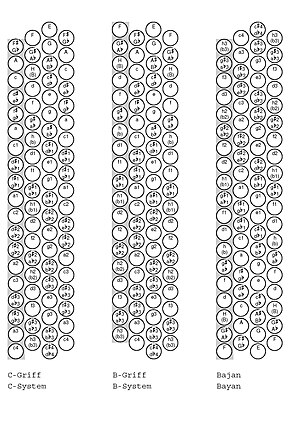A free-bass system is a system of left-hand bass buttons on an accordion, arranged to give the performer greater ability to play melodies with the left-hand and form one's own chords. The left-hand buttonboard consists of single-note buttons with a range of three octaves or more, in contrast to the standard Stradella bass system, which offers a shorter range of single bass notes, plus preset major, minor, dominant seventh, and diminished chord buttons. (Pressing a single preset chord button sounds a three-note chord.) The term "free-bass system" refers to various left-hand manual systems that provide this functionality:[1] The Stradella system does not have buttons for different octaves of the bass notes, which limits the types of melodies and basslines that can be performed with the left hand.

- Two related layouts exist as mirror versions of the chromatic button accordion, these were marketed in the US by the Giulietti Accordion Company as "Bassetti".[2][3][4][5]
- The "quint" free-bass system invented by Willard Palmer – later patented by Titano, has extra bass rows to extend the existing bass arrangement of the Stradella system.[6]
- The quint version and chromatic-button versions were available in "converter" (or "transformer") models with a control to switch from standard Stradella to free-bass.[7]
- A piano-like layout exists that mirrors the right-hand keyboard of a piano accordion, with round buttons laid out like piano keys. This system is popular in Asian piano accordions, especially in Azeri garmon.
- A hybrid Chromatic/Stradella system known as the Moschino free-bass system is available. The system arranges the left-hand buttons so chromatic arrangement of keys, adjoining Circle-of-Fifths, chord inversions, and alternate chord voicings are available to the player simultaneously. A famous accordion musician and proponent of the advantages of the Moschino free-bass system was George Secor, and links to a more detailed description of the system is included on his wikipedia page.
- Other less popular arrangements exist, such as the Kuehl system.
- ^ Dan Lindgren, "Free-bass Systems Compared"
- ^ "Freiburger accordion workshop, document on free bass". Archived from the original on 1 May 2007.
- ^ Index of patents Issued by the United States Patent Office, 1968, p. 481 - Giulietti Accordion Co. - Patent issued for the bass section of the accordion on Google Books
- ^ The Giulietti Sound: In Search of the History of My Accordion. Neijnens, Sander. The Netherlands, 2008 The Giulietti Sound on wolrdcat.org
- ^ "The Purchaser's Guide to the Music Industries, 1972. p. 168 Giulietti Accordion Corporation in New York City on Google Books
- ^ "Titano Accordion Company, History". Retrieved 27 March 2012.
- ^ "Converter Bass". Retrieved 8 June 2014.
